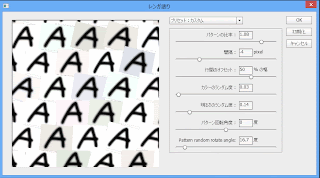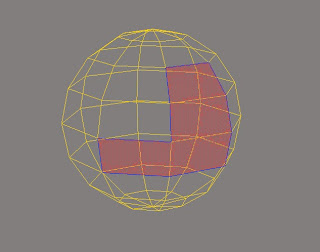
PhotoshopCCには塗りつぶしパターンに、
スクリプトが使えるようになった。
レンガのスクリプトがあったのだけど
ランダムの回転が無かったので足してみた。
本当はタイルパターンに対応させてみたかったのだけど、
色の変化は、ランダムに付けられるので、ちょっと見送り。
感触としては悪くないかも
ソース
///////////////////////////////////////////////////////////////////////////////////////////////////////////////////////////////////////////////////////////
// Here are a few parameters that you can change to modify the behavior of the patterm
// Feel free to modify the values, don't change the variable names
modelParameters = {
// scaling of the input pattern
patternScale : 1,
// Offset between rows of pattern expressed in percent of pattern width.
// For example 50% is half the width.
offset : 50, // use a value between 0 and 100. The default is 50.
// Spacing between patterns in pixels.
// For example,1 creates 1 pixel gap between patterns
spacing : 0, // use a value between -10 to 20. The default is 0.
// Variation of color of the pattern.
// For example, value of 0.2 means that each of the red, green, and blue color components
// will be multiplied by a DIFFERENT random value from interval 0.8 and 1.2.
// Set to 0 if you do not want to modify the pattern color.
colorRandomness : 0.05, // use a value between 0 and 1. The default is 0.05.
// Variation of pattern brightness.
// For example, value of 0.6 means that each of the red, green, and blue color components
// will be multiplied by THE SAME random value from interval 0.4 and 1.6.
// Set to 0 if you do not want to modify the pattern brightness.
brightnessRandomness : 0.1, // use a value between 0 and 1. The default is 0.1.
// Rotation of individual patterns.
rotateAngle : 0, // Use a value between -180 and 180. The default is 0.
//Rotate Randmaize
rotateAngleRandomness : 0
}
///////////////////////////////////////////////////////////////////////////////////////////////////////////////////////////////////////////////////////////
// You can modify the code below but keep in mind that as with any scripting
// you can break things. Keep a backup copy.
///////////////////////////////////////////////////////////////////////////////////////////////////////////////////////////////////////////////////////////
// Get pattern and its size
var pattern = RenderAPI.getParameter(kpsPattern)
var patternSize = pattern.getParameter(kpsSize)
var patternSizeForDialog = Math.max (patternSize.x, patternSize.y)
function run (api, parameters, scale)
{
// get the size of the output area
var outputSize = api.getParameter(kpsSize)
// get the location of the top left corner of the bounding rectangle around the selected area
var outputOrigin = api.getParameter(kpsOrigin)
var patternSize = pattern.getParameter(kpsSize)
patternSize *= parameters.patternScale
// to finetune the progress bar, specify how many pixels are covered by patterns - the bigger the spacing the lower the value, for example
api.setParameter(kpsPixelCoverage, 0.5 * (patternSize.x * patternSize.y) / ((patternSize.x + parameters.spacing) * (patternSize.y + parameters.spacing ) ) )
// compute the pattern size in x and y after rotation
var rotSizeX = patternSize.x * Math.abs( Math.cos(parameters.rotateAngle / 180.0 * Math.PI)) + patternSize.y * Math.abs( Math.sin(parameters.rotateAngle / 180.0 * Math.PI))
var rotSizeY = patternSize.x * Math.abs( Math.sin(parameters.rotateAngle / 180.0 * Math.PI)) + patternSize.y * Math.abs( Math.cos(parameters.rotateAngle / 180.0 * Math.PI))
// possibly add spacing
if (patternSize.x + parameters.spacing >= Math.min (5, patternSize.x) )
patternSize.x += parameters.spacing
else
patternSize.x = Math.min (5, patternSize.x)
if (patternSize.y + parameters.spacing >= Math.min (5, patternSize.y))
patternSize.y += parameters.spacing
else
patternSize.y = Math.min (5, patternSize.y)
// scale up if the patternsize is 1 to avoid long loop
if (patternSize.x == 1 && patternSize.y == 1)
{
if (scale == 1)
scale = 20
}
patternSize *= scale
//patternSize *= 2
api.translateRel (patternSize.x/2, patternSize.y/2)
// negative origin may happen for preview of very small documents
if (outputOrigin.x < 0)
outputOrigin.x = 0
if (outputOrigin.y < 0)
outputOrigin.y = 0
api.translateRel ( -(outputOrigin.x % patternSize.x), -(outputOrigin.y % patternSize.y))
var row = Math.floor( outputOrigin.y / patternSize.y )
var column = Math.floor( outputOrigin.x / patternSize.x )
var extraRows = 0 // on each side, if needed
var extraColumns = 0
if (parameters.rotateAngle != 0 || parameters.spacing < 0)
{
// start a few rows or columns earlier because the tips of rotated patterns may show up in the selection
// or because the spacing is negative and transparent patterns to the left would still show up
extraRows = Math.floor (rotSizeY / (2 * patternSize.y) + 0.4999)
extraColumns = Math.floor (rotSizeX / (2 * patternSize.x) + 0.4999)
row -= extraRows;
column -= extraColumns;
api.translateRel ( -patternSize.x * extraColumns, -patternSize.y * extraRows)
}
pattern.setParameter (kpsColorBlendMode, kpsBlendMultiply)
//pattern.setParameter (kpsColorBlendMode, kpsBlendLinearLight)
//Add Trea patern BlendMode
//RenderAPI.setParameter(kpsUseOpenGL, 0)
//pattern.setParameter(kpsPatternBlendMode,kpsBlendLighterColor)
//pattern.setParameter(kpsPatternBlendMode,kpsBlendDarkerColor)
//var margin_y = Math.max(patternSize.y, -parameters.spacing)
var margin_y = patternSize.y + 2 * extraRows * patternSize.y
for (var y = 0; y < outputSize.y + margin_y; y+= patternSize.y, row++)
{
api.pushMatrix()
var x = 0
//if ( (row%2) == 1)
{
var shift = parameters.offset*0.01 * row
api.translateRel( ((shift - Math.floor(shift)) - 1)* patternSize.x, 0)
x = - patternSize.x // one extra, just in case
}
//var margin_x = Math.max(patternSize.x * (1 + parameters.offset*0.01), -parameters.spacing)
var margin_x = patternSize.x + 2 * extraColumns * patternSize.x
for (var c = column; x < outputSize.x + margin_x; x+= patternSize.x, c ++)
{
api.pushMatrix()
// Set the seed based on the current row and column - this assures that the color will be modified
// in the same way for the pattern in the neighboring selected area
var seed = (row * 214013+ c * 2531011) % 0x7fffffff //
//Engine.rand(seed)
//Engine.rand(); // it helps to call rand a few times beforor using it since we are forcing the seed.
var rc = parameters.colorRandomness // color randomness
var br = 1 - parameters.brightnessRandomness + Engine.rand(seed) * parameters.brightnessRandomness*2 // brightness
api.Color (kFillColor, br *(1 - rc + Engine.rand()*rc*2), br*(1 - rc + Engine.rand()*rc*2), br*(1 - rc + Engine.rand()*rc*2))
//api.scale(rand()*0.1 + 1)
//api.rotate(-4 + Math.floor(rand()*60) / 7.5) // 60 distinct rotations - to help cache
//api.rotate (Math.floor(rand()*10) * 18)
api.rotate (parameters.rotateAngle)
//追加
api.rotate (parameters.rotateAngleRandomness * Engine.rand() )
api.scale(scale)
api.scale(parameters.patternScale)
pattern.render(api)
api.popMatrix()
api.translateRel(patternSize.x, 0)
if (restart)
return;
}
api.popMatrix()
api.translateRel(0, patternSize.y)
}
}
/////////////////////////////////////////////////////////////////////////////////////////////////////////////////////////////////////////////////////////////////////
// Menu start
// If you want to create a menu in which you change some of the script parameters, include the following code:
// For shipped scripts we can include localized strings, prefixed with $$$/ - call method localize(string) on the prefixed string
// For your own strings, you can query app.locale and select several language versions (for example, your native language and english). Try alert ("Language is: " + app.locale)
var decoMenu = { // an object that defines the menu
menuTitle : localize("$$$/DecoScripts/BrickFill/BrickFill=Brick Fill"),
menuBackground : [0.93, 0.93, 0.93, 1],
previewBackground : [1, 1, 1, 1],
panels : [
{ panelName : "",
leftColumnWidth : 180,
unitsWidth : 65,
editTextWidth : 37,
panelMenu : [
{ itemName : localize("$$$/DecoScripts/PatternScale=Pattern Scale:") ,
itemUnit : "", itemType : 'slider', itemValue : modelParameters.patternScale, itemMin : 0.1, itemMax : 1.25, itemStep : 0.01, varName : 'patternScale' },
{ itemName : localize("$$$/DecoScripts/BrickFill/Spacing=Spacing:"),
itemUnit : localize("$$$/DecoScripts/Units/pixels=pixels"),
itemType : 'slider', itemValue : modelParameters.spacing, itemMin : -patternSizeForDialog+1, itemMax : Math.max(100, 3 * patternSizeForDialog), itemStep : 1, varName : 'spacing' },
{ itemName : localize("$$$/DecoScripts/BrickFill/Offset=Offset between rows:") ,
itemUnit : localize("$$$/DecoScripts/Units/percentOfWidth=% of width"),
itemType : 'slider', itemValue : modelParameters.offset, itemMin : -100, itemMax : 100, itemStep : 0.1, varName : 'offset' },
{ itemName : localize("$$$/DecoScripts/ColorRandomness=Color randomness:"),
itemUnit : "", itemType : 'slider', itemValue : modelParameters.colorRandomness, itemMin : 0, itemMax : 1, itemStep : 0.01, varName : 'colorRandomness' },
{ itemName : localize("$$$/DecoScripts/BrightnessRandomness=Brightness randomness:"),
itemUnit : "", itemType : 'slider' , itemValue : modelParameters.brightnessRandomness, itemMin : 0, itemMax : 1, itemStep : 0.01, varName : 'brightnessRandomness' },
{ itemName : localize("$$$/DecoScripts/BrickFill/rotateAngle=Pattern rotate angle:"),
itemUnit : localize("$$$/DecoScripts/Units/degrees=degrees"),
itemType : 'slider', itemValue : modelParameters.rotateAngle, itemMin : -180, itemMax : 180, itemStep : 1, varName : 'rotateAngle' }
//追加
,
{ itemName : localize("$$$/DecoScripts/BrickFill/rotateAngleRandomness=Pattern random rotate angle:"),
itemUnit : localize("$$$/DecoScripts/Units/degrees=degrees"),
itemType : 'slider', itemValue : modelParameters.rotateAngleRandomness, itemMin : 0, itemMax : 180, itemStep : 0.1, varName : 'rotateAngleRandomness' }
//追加おわり
] }
] // end of panels
}; // end of menu
// If livePreview is set to 1, the preview image is updated live. Note that due to limitations of scripted menus the update is slow and the flickering may be disturbing.
livePreview = 0 // recommended value is 0
// Call Photoshop Script that creates the menu
Engine.evalFile ("_Deco Menu.jsx")
// Menu finished
/////////////////////////////////////////////////////////////////////////////////////////////////////////////////////////////////////////////////////////////////////
if (typeof skipRun == 'undefined' || !skipRun) // run unles we exited the preview window without pressing a button
run(RenderAPI, modelParameters, 1)
気づいた事
・マスクが使えない(重なり合う所はNG)

